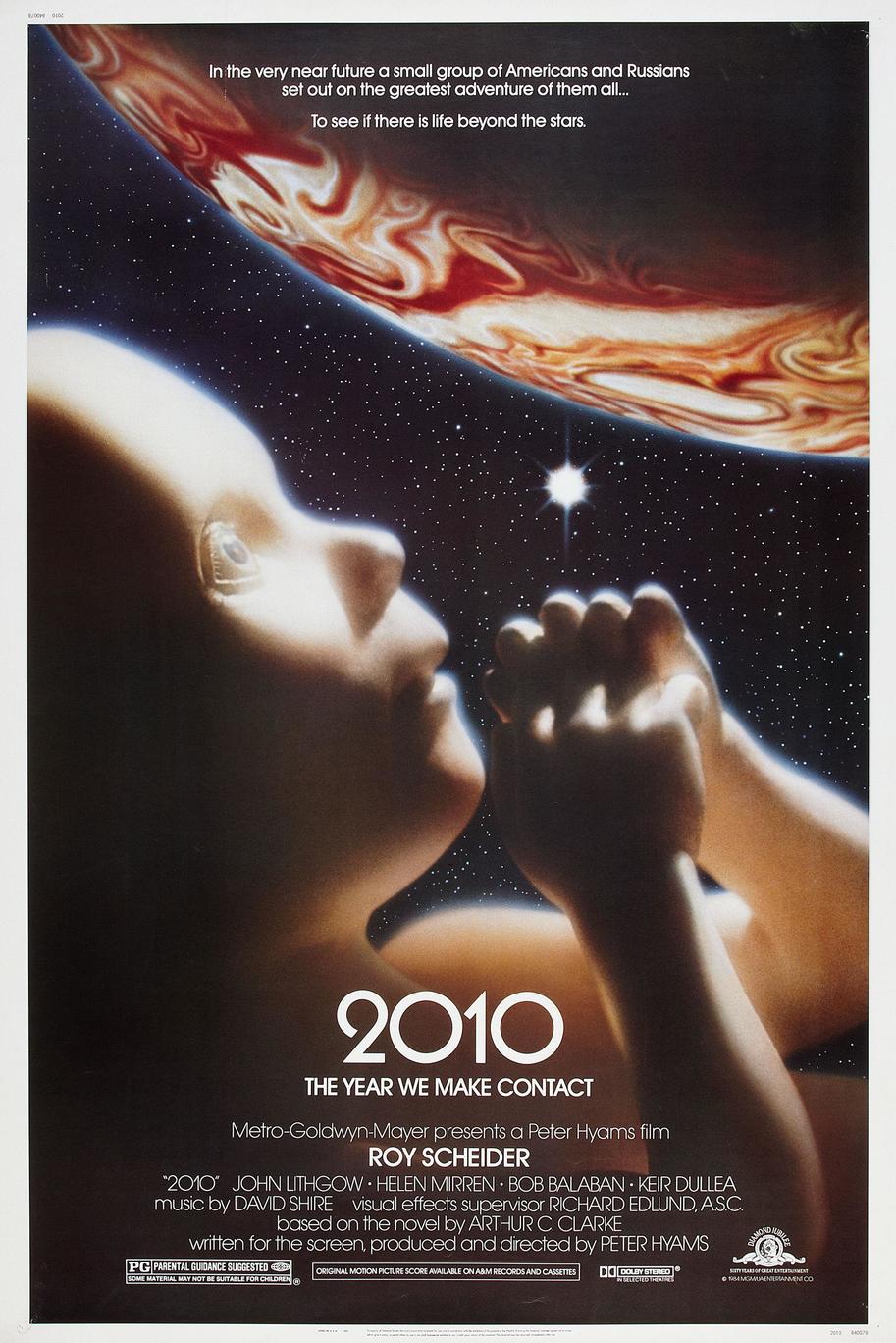
As far as sequels to classics go, Peter Hyams 2010: The Year We Make Contact, an underrated sequel to 2001: A Space Odyssey, isn’t bad.
THE PLAYERS: Starring: Roy Scheider, Helen Mirren, John Lithgow, Bob Balaban and Keir Dullea. Music by David Shire. Written and directed by Peter Hyams.
THE HISTORY: Crafting a sequel to Stanley Kubrick’s 2001: A Space Odyssey sounds like a fool’s errand. Being that it’s one of the most acclaimed films ever made, in order to be judged any kind of success the sequel would have to be some kind of masterpiece. In 1984, director Peter Hyams, coming off the success of Capricorn One and some mid-level studio programmers (The Star Chamber, Outland) decided to give it a go. He based it on author Arthur C. Clarke’s well-received sequel to the book the original 2001 was based on, and MGM, celebrating their “diamond jubilee” (60th anniversary) gave him a healthy $28 million budget. With star Roy Scheider coming off Blue Thunder, and co-star John Lithgow having recently had back-to-back Oscar nominations (for The World According to Garp and Terms of Endearment), it looked for a while like 2010: The Year We Make Contact was going to be a solid hit, with Kubrick himself giving the film his (reserved) blessings.

I had a long conversation with Stanley and told him what was going on. If it met with his approval, I would do the film; and if it didn’t, I wouldn’t. I certainly would not have thought of doing the film if I had not gotten the blessing of Kubrick. He’s one of my idols; simply one of the greatest talents that’s ever walked the Earth. He more or less said, ‘Sure. Go do it. I don’t care.’ And another time he said, ‘Don’t be afraid. Just go do your own movie. – Peter Hyams – interview with Kubrick biographer Vincent LoBrutto
Alas, 2010: The Year We Make Contact was little more than a middling success. The reviews were respectful, if not overly enthusiastic. Contrary to popular opinion, the film was not a financial fiasco, actually grossing a decent (for 1984) $40 million, and doing well on the then-nascent home video market. Even still, over the years the film vanished into obscurity, not helped by the end of the Cold War, which made the premise of the U.S being on the verge of war with the Russians, prematurely dated (oh how the times have changed), leaving it as little more than a curio for fans.

WHY IT’S GREAT: I’m not going to make a case for 2010 as being a worthy follow-up to Kubrick’s film. I’m of the mind that a sequel to a genre-defining classic like that is always a bad idea (it would be like doing a sequel to Casablanca or Citizen Kane), but Hyams deserves some credit for making a pretty damn decent sci-fi drama that would likely be held in much higher esteem were it not a sequel. It’s an interesting counter-point to the quintessential eighties blockbuster, which always painted the Soviet villains as bloodthirsty maniacs. Here, the conflict between the two nations is presented as mere ideology and that when you get down to it, the Soviet astronauts and their American counterparts aren’t all that different – finding common ground early on. In that way, this is a convincing plea for peace, although it’s certainly a bit quaint to see a film set in 2010 where the political problems haven’t evolved beyond the eighties (oh, wait…).

It helps that Hyams put together one heck of a good team, drawing-in a much better-than-average cast, including Roy Scheider, who was still in his post-JAWS sweet spot as the quintessential Hollywood every man. He’s maybe a little too blue-collar to be playing the intellectual Heywood, but he makes for a likable hero. Helen Mirren, as the Soviet captain, makes for an intriguing counterpoint, and their respectful, if lightly adversarial relationship is well-conveyed throughout (I also appreciate the distinct lack of any romance between the two – which would have been cliché). Ditto John Lithgow as Discovery One’s designer, and the great Bob Balaban as Hal’s programmer.
Probably the biggest “get” of 2010, is that Keir Dullea and Douglas Rain were back to recreate their roles as Bowman and Hal. One of the big changes in the sequel is that Hal’s now a good guy, with some dialogue explaining that Hal was reprogrammed by meddling White House spies and that now that he’s been cleared of his bad wiring, is now a benevolent figure. In fact, he’s almost presented as a Christ-like figure by the end, but it’s a nice twist, as it would have been easy for Hyams to have used Hal to make this into a generic thriller, something he avoids. They also go light on the classical music, opting for an electronic score by David Shire which, though dated, is pretty good. All-in-all, this is a lot more Apollo 13 than Star Wars.
SEE IT: 2010 is out on Blu-ray and Digital HD.
PARTING SHOT: Peter Hyams was an interesting director. He wrote and directed enough of his movies that a case could be made for him being an auteur (he even DP’d a lot of them himself), but he’s generally regarded as more of a journeyman due to the fact that he opted to mostly shoot studio programmers. Some of these are really well-done (Running Scared), some not (The Relic, A Sound of Thunder), but 2010 belongs with Capricorn One as an example of him at his best. Again, this isn’t anywhere near the level of Kubrick’s film, but it’s much better than it had any right to be, and it’s worth checking out for the curious fan who can separate it from the original.

Originally published at https://www.joblo.com/the-best-movie-you-never-saw-2010-the-year-we-make-contact/